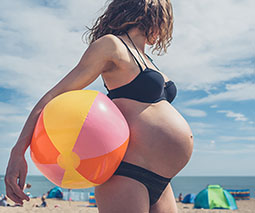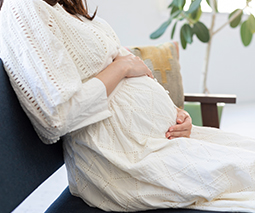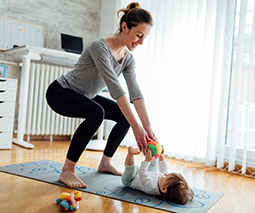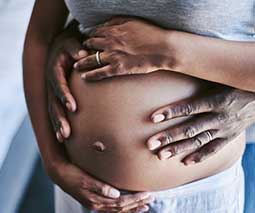How to know if you’re doing too much or not enough while pregnant
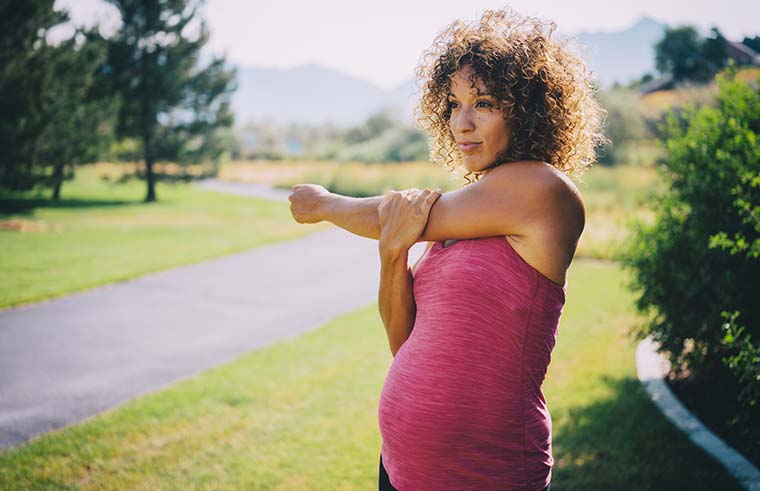
When I was pregnant with my first baby, I remember feeling like I was carrying a fragile bean inside me that could fall out at any time if I wasn’t careful. I worried about early miscarriage and took great care not to over exert myself. Even making the bed freaked me out. Was I overdoing it by pulling and tugging on bedding? Putting myself at risk of miscarriage because of a stubborn fitted sheet?
I was totally confused about how much physical activity a pregnant woman could do without harming herself or the baby. Needless to say, when Charlotte in the Sex and the City movie finally fell pregnant and decided to continue jogging, I was gripped with anxiety. What is she thinking? I thought. Surely running isn’t safe during pregnancy??
Confusion about exercise
Turns out I really had no idea. Not only is exercise safe and hugely beneficial during pregnancy, but our bodies are made of much tougher stuff than I ever realised. The trouble is, lots of us don’t realise and think that we need to be careful not to overdo it while we’re pregnant.
While pregnant women should rest when their body needs it, keeping physically active can be thought of as essential preparation for birth and motherhood. Not only can it help us birth better and recover from it faster, but it means that we’re able to be the strong, healthy mum our baby needs us to be when they arrive.
But if you’re like lots of other pregnant women, you’re probably wondering where to start on the exercise front. Can you continue with your body step class? Can you start an exercise program to help monitor your weight gain during pregnancy? And if you don’t normally exercise, what sort of physical activities are safe to do throughout pregnancy?
It’s this sort of confusion that means lots of pregnant women aren’t getting as much physical activity as they should be, and that means they’re missing out on a whole range of benefits that regular movement can bring to a healthy pregnancy.
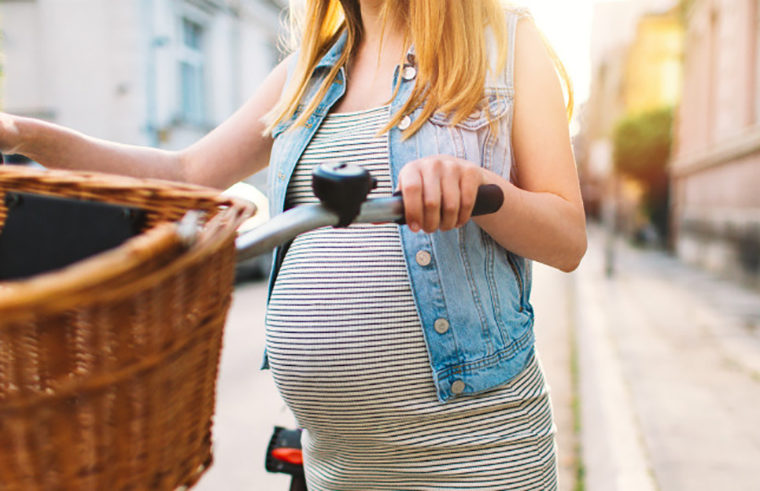
How exercise can help during pregnancy
Rachel Livingstone, personal trainer and creator of Glowing Expectations, an online fitness program for pregnant women, agrees that staying active and exercising regularly during pregnancy is a good thing.
“Unless a doctor specifically says otherwise, it is not only safe but actually beneficial to exercise in pregnancy, and that’s for both mum and her growing bub,” says Rachel.
The right sort of exercise can help you birth your baby, recover from the birth and even assist you with adjusting to motherhood.
“When are we going to train for motherhood, if it’s not during pregnancy?” Rachel asks. “There’s more bending, lifting and carrying during motherhood than at any other time, so your core needs to be strong then. We’ve got to keep exercise going during those nine months, otherwise it’s got a lot of time to de-condition.”
The benefits of exercise during pregnancy don’t end there. As well as helping you prepare for birth and the physical demands of motherhood, regular physical activity can help with pregnancy aches and pains, keep your blood pressure in check, help you sleep at night, feel better about your changing body and even ward off depression and anxiety.
What to keep in mind each trimester
Rachel says that women need to consider their individual circumstances and where they’re at in their pregnancy when considering exercise. Consultation with an experienced personal trainer can help tailor an exercise program that meets your needs – just don’t forget to keep your midwife and GP in the loop as well.
First trimester
“In the first trimester what most women will struggle with is nausea, tiredness, headaches and a fear of what to do [in terms of exercise],” says Rachel.
This means following your body’s lead. If you’re exhausted and feeling sick, don’t push yourself to exercise, as your body is working really hard already. If physical activity feels okay to do, make sure you stay hydrated and monitor how you’re feeling, stopping if you get too tired or feel dizzy.
Second trimester
During the second trimester, many women report feeling energised as nausea lifts and a growing bump is still yet to get in the way of physical activity. This is a great time to be as active as possible, but be aware that by the end of this period, your uterus will have moved up and out of your pelvis and will cause your centre of gravity to shift, so the way you move or exercise will need to be reviewed once your bump is out and about.
Third trimester
Once you’re in your third trimester, it’s really time to listen to how your body is coping with exercise and scale back as necessary, all the while consulting with your GP or midwife about the level of exercise you should be continuing with. In terms of general physical activity, you should be okay to keep walking, using the stairs and keeping busy, but look out for any light-headedness and extra aches or pains, as your body will let you know if you need to start resting up. Consult with your GP if you experience any signs of early labour, vaginal fluid/bleeding, early contractions or anything else that doesn’t feel right.

What sort of physical activity is safe during pregnancy?
Rachel says that while the guidelines for exercise during pregnancy offer basic information, there is more to consider before embarking upon an exercise program when you’re pregnant, such as your fitness experience.
“There’s a general rule that the more exercise a pregnant woman did before pregnancy, the more she can do during pregnancy.” In other words, you should be guided by what your exercise levels were like before you fell pregnant. If walking three times a week is what you managed pre-pregnancy, then this is the level of exercise you can maintain during pregnancy. On the other hand, if you’re a regular gym-goer, you can maintain a similar level of activity, with some tweaks to accommodate your changing body.
Generally speaking, light cardio, swimming, walking and strength training are considered safe exercises, as long as you don’t overdo it. Rachel says that pregnant women should consult with a personal trainer who specialises in prenatal exercise, in conjunction with the woman’s doctor.
“It’s not black and white, it’s different for different women throughout pregnancy and even between pregnancies,” she says, adding that it’s important for pregnant women to keep their personal trainer informed and up-to-date with any recommendations her doctor makes as her pregnancy progresses.
What physical activity should be avoided during pregnancy?
While most cardio exercise is suitable during pregnancy, there are some activities that you should avoid because of the risk of falling or getting hit. Examples include cycling (although using a stationary bike is fine), horse riding, skiing, boxing, cricket and potential contact sports such as netball, football or basketball. It’s not so much the nature of the exercise that isn’t safe for your pregnant body, but the risk of losing your balance or collision.
Rachel also advises that because of your changing core strength, heavy abdominal work, leg raises and sit-ups should be avoided altogether during pregnancy. “Keep intensive abdominal workouts until much later after pregnancy and focus instead on gentle core activation,” she says.
If exercise still worries you …
Rachel suggests that as well as the recommended exercise guidelines and your fitness capabilities, there’s a third, very important thing to consider.
“The third thing is your personal pregnancy journey. If you’ve had three miscarriages or spent seven years trying to get pregnant, you may want to be more conservative, for your own sanity. Whether your doctor or trainer says to you ‘this is fine’, if you can’t feel that inside, don’t do the suggested exercise. Just keep active, find the level at which you feel comfortable at and focus on staying active there.”
For you this might mean sticking to day-to-day tasks around the house and walking around the shops. It doesn’t matter if you’re not sticking to a specific exercise program. What matters is that you’re keeping active at a level that suits you.
Making sure you don’t overdo it
Whether you’re busy running around the house or engaging in formal exercise, it’s okay to get your heart pumping and to even go a bit pink in the face. However, Rachel advises that pregnant women need to keep an eye on their level of intensity to make sure they’re not overdoing it.
“When it comes to monitoring intensity, women can try the ‘Talk Test’ – can I talk whilst I’m exercising? If you can’t, if you’re gasping for air and can’t get the words out, it’s too intense for pregnancy.”
Another way to keep check on your ‘overdoing it’ rating is to consider your perceived rate of exertion on a scale from zero to 10, suggests Rachel, where zero is ‘no working out at all’ and 10 is the ‘most intense your workout could possibly be’.
“Generally speaking, somewhere around six to seven is suitable for pregnant women. But if you’re in your first trimester and you’re feeling tired, four to five may be more appropriate for you. If you’re winding down at the end of pregnancy, four to five might again be appropriate. But in the middle phase (second trimester), you still don’t want to go above six to seven.”
Always listen to your body
Exercise and keeping physically active is good for you, but you need to listen to your body at all times. Don’t exercise to the point of exhaustion, and if you’re not feeling well, or simply don’t want to be especially active one day, don’t be.
While you are being physically active, avoid raising your core body temperature too much and make sure you stay well hydrated. Also bear in mind that your body will begin to tire out as your pregnancy nears its end. High impact activities could put pressure on your ligaments and pelvic floor muscles, which mean it’s important to wind down your level of exercise once you’ve hit the third trimester.
Other indicators that you should stop exercising immediately include shortness of breath, vaginal bleeding, contractions and any other pain in your body that doesn’t feel right.
When you shouldn’t exercise at all
Some pregnant women need to be cautious about physical activity and should consult with their midwife or GP before starting exercise during pregnancy. For example, if you’ve had vaginal bleeding during the pregnancy, are pregnant with multiples, have high blood pressure or a low lying placenta, you may be advised to limit your activity.
To be safe, always check with your midwife and GP before starting or continuing with exercise during the pregnancy.
On your feet a lot?
For most women with healthy pregnancies, standing for long periods of time isn’t an issue. However, if you have a small baby or you’re at risk for early delivery, being on your feet too much could put you further at risk. See your GP if you have either of these conditions.
Generally speaking though, standing around is fine, although if you can move your legs often, this will help keep your blood moving and stop your muscles from aching. Try walking on the spot or going for a short walk every so often.
Physical activity won’t cause a miscarriage
“While it’s normal for pregnant women to feel unsure about physical activity and exercise during pregnancy, rest assured that keeping active is a good thing to do and won’t cause a miscarriage,” says Rachel emphatically. “Miscarriage is an unfortunate thing, but it’s unlikely to be caused by exercise, unless you did something that was incredibly extreme.”
Obviously, if you experience any pregnancy complications or your pregnancy becomes high-risk, this will need to be discussed with your personal trainer and medical team who can advise you whether it’s safe to continue being physically active. If your pregnancy is healthy and you feel okay with being physically active, then go ahead and do it without worrying yourself.
By taking into account your previous exercise levels and consulting with an experienced personal trainer and your GP, regular movement and formal exercise can help you have a healthy pregnancy and birth.
As long as you continue to listen to your body and monitor your own intensity levels, you and your baby will reap the rewards exercise can bring.
 Join the Bump and Baby: The Fourth Trimester online event! With live expert sessions, FREE newborn routine guide & the chance to WIN a $500 Nursery gift voucher. Click here to find out more and make sure you don’t miss a thing!
Join the Bump and Baby: The Fourth Trimester online event! With live expert sessions, FREE newborn routine guide & the chance to WIN a $500 Nursery gift voucher. Click here to find out more and make sure you don’t miss a thing!


